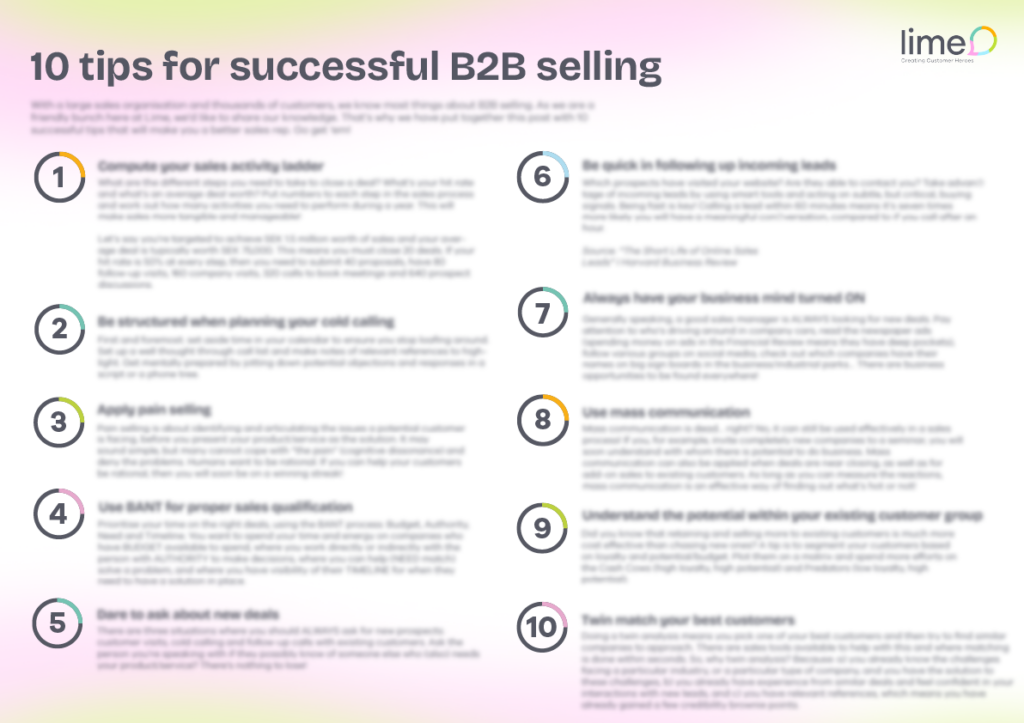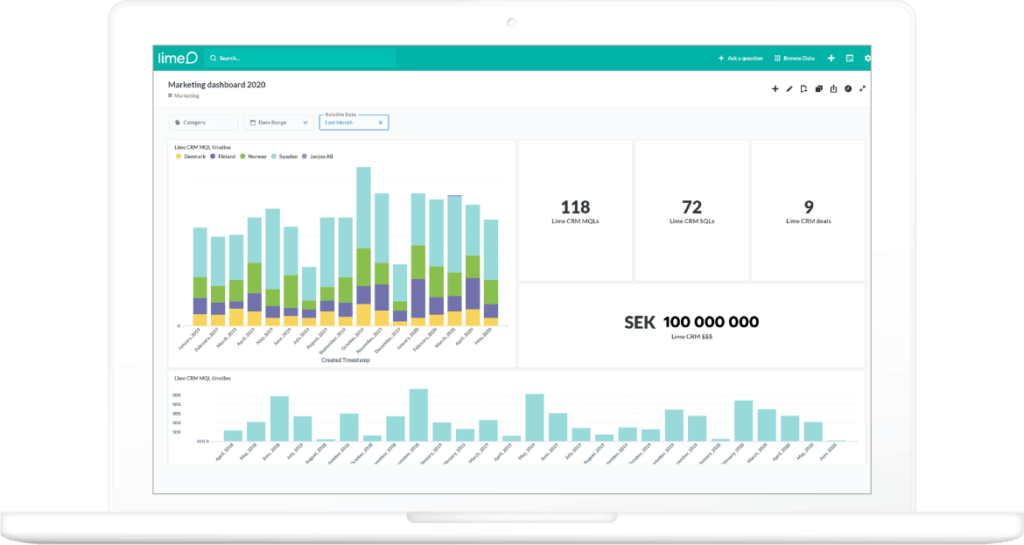
Get a better B2B sales strategy with our guide
A sales strategy is your team’s roadmap to success, aligning activities with company goals. By tracking progress directly in your CRM, you can adapt and maximise results. Start by answering six key questions to build a strategy that grows with your business.
Your company’s sales strategy is a roadmap for the sales team. It guides the sales team to prioritise the right activities to achieve the company’s goals together. The roadmap describes where you are today, where you want to be and how to get there.
This makes the sales strategy a living document that’s should be in line with the overall goals and vision of the business. The sales strategy grows and changes as your company evolves. Maximise sales by tracking your goals and results directly in your CRM.
But where do you start? By answering six questions, you can easily build a sustainable sales strategy for your business:
- Who do you sell to?
- What do you sell?
- How do we sell?
- When do we sell?
- Who is selling?
- What works right now?
Keep reading for our top tips and advice on developing a sales strategy. With the help of carefully selected questions and proven tricks, you will soon have a sales strategy that your salespeople can follow and expand upon. Even if you don’t have answers to all questions today, you can view the upcoming workshop discussions as a seed for your future sales strategy.
Smarter sales with a 360° overview
Learn why Lime is the best one-stop shop for your sales team.

Workshop: Create a sales strategy that helps you grow
Few organisations are able to grow over time without a strategy to achieve their goals. Growth depends on having measurable goals and a plan on how to reach them. Having a sales strategy in place makes it easier to navigate the challenges that all organisations face sooner or later.
The best way to develop a new sales strategy is to bring the sales team together for a workshop. Through clarity and transparency, a clear expectation is created within the team and the organisation. This makes it easier for each individual employee to contribute in the best possible way to achieve the set goals of the organisation.
What do you need for the workshop?
- All sales people together – if you are more than six people, you can split into several, smaller teams.
- A whiteboard or interactive board to document each step. Summarise the points and create a document for the future sales strategy.
Material that help you answer the questions:
- The companies business strategy and vision to guide the way forward.
- Defined targets with KPIs for the sales team and individual performance.
- A structured sales process with prioritised activities.
- A CRM system where you can set targets and KPIs for your priority sales activities.
A sales strategy should describe your target customer
Who do we sell to?
There are a vast amount of companies around the world, all with different needs and interests. Who do you sell to? Defining your target audience and ideal customer is an important strategic decision. If you aim too broad you risk spending time on prospects who are not in the right position to become customers.
Start by identifying what kind of business you want to contact. Then you can start thinking about who your potential buyers are.
- Does your ideal customer have a certain number of employees?
- What is the turnover of your ideal customer?
- Do you target the private or public sector?
- Do you target one or more industries?
- Who buys your services or products? Please indicate one or more titles of who might be responsible.
You can go narrow and niche or more broadly with who’s your ideal customer. The better you understand your ideal customer, the easier it will be to present the buyer at the company with an attractive offer.
Make a SWOT- analysis to find your USPs
What do we sell?
A question that might seem obvious – of course you know what you’re selling. But your client might not. They probably don’t even know how you differ from your competitors. The matter of the fact is, most B2B-customers don’t see any difference between the various suppliers in the market.
Do you know how your company is different from your competitors? Does everyone in the sales team know what your USPs (Unique Selling Points) are, or are they just repeating the same old message to the customer?
A great way of starting the process is by doing a SWOT- analysis, this will map out your
Strengths
Weaknesses
Opportunities and
Threats.
- Strengths: What are you really good at?
Start with writing down all of your organisation’s strengths. They can be everything from how well you communicate and collaborate between co-workers to how well your products perform compared to your competitors.
- Weaknesses: Where are you vulnerable?
You might not want to reflect on your own weaknesses, but it’s important to understand which strategies and sales techniques are profitable, and the one’s that aren’t. This is also where you might find important internal processes that are missing or that needs to be clarified.
- Opportunities: What opportunities do you see in the market?
Take an external perspective when writing down your opportunities. For example, you may be able to do much of your sales digitally or remotely instead of face to face. Another example could be that your offer is completely unique to your target group which can get you ahead of the competition.
- Threats: What challenges do you face?
This is where you need to be aware of the market and your competitors. Has your primary competitor been acquired by a larger company and is therefore sitting on more capital than before? Has the behaviour of your target audience changed in a way that you are finding difficult to respond to?
With a SWOT-analysis you define your USPs (Unique Selling Points). A USP is something unique that only you offer. This creates a value for your clients, short and long term. The aim is to find gaps where you deliver something of higher value to the customer compared to the competition.
Want to learn more?
With a large sales organisation and thousands of customers, we at Lime have learned the ins and outs of B2B sales. Here are our top tips that takes your B2B sales to the next level!

A B2B sales strategy involves more than the sales team
How do we sell?
The B2B-landscape is rapidly changing. The role of the salesperson is moving from outreach to ambassadorship for the business. The salesperson is the public face of the business, but not the only one. The marketing department, customer service and the development of products and services also influence the customer’s interest in buying your particular services or products.
Why you sell more with storytelling
Conveying the same image and message of your business – whether on your website, in social media, on the phone or in meetings – is essential to building a strong brand and increasing your sales. For this reason, your organisation’s vision and story become particularly important. In addition, storytelling is a very effective way for customers to remember your business. Remember that most B2B customers doesn’t see any difference between suppliers of similar products. With a strong story, it’s easier to quickly create an emotional tone in the sales conversation. After all, we sell to people, not organisations.
Marketing activities as part of the sales strategy
An ongoing trend in B2B sales is to share free information with customers. The reason is that customers often choose a supplier before they even make contact with a salesperson. Here, collecting leads via the website and email marketing can be an important aspect to include in your sales strategy. Working closely with the marketing department is a winning concept for most sales teams.
What internal opportunities are there for collaboration between departments?

Strategic choices in communicating with prospects
Do you want to be a well of knowledge for your customers? Then it’s extra important that salespeople know their products ins and outs to provide customers with the expertise they expect. Do you want to be the vendor that’s always available? Set targets for how quickly incoming leads should be handled and ensure that you always follow up on questions from both prospects and customers. These are small but strategic choices that go a long way to determining how your prospects perceive you as a supplier.
How can you use your daily communications with customers to stand out as a supplier?
The process is an important part of your sales strategy
When do we sell?
It can be difficult to determine when a customer is ready to make a purchase without carefully evaluating which sales activities are working. The foundation of effective selling is a structured sales process that helps the salesperson to constantly move the deal forward.
To develop a clear sales process, you need to identify all the steps in the sales cycle. This makes it easier for the salesperson to move each potential customer closer to a deal. The sales process eventually turns into the customer journey, where follow-up and upselling are two key activities to prioritise.
The advantage of a structured sales process is that sellers:
- will have an even distribution of prospecting, cold calling, sales calls, and administrative tasks.
- can be clear with the costumer about what the next step is.
- clearly see if they are in line with the sales objectives.
Establish KPIs at team and individual levels
Who is selling?
Nobody is a lonely island in an organisation. Despite this, many sales organisations use individual commission-based pay. This creates a sales culture that raises individual performance but is not necessarily based on creating a sales organisation that can perform over time. A sales strategy allows the sales team to work more effectively.
By analysing who is driving home what type of business, you can adapt and allocate work to match your sales strategy. Individual KPIs are useful if they can be used to support salespeople to perform better.
Keeping the sales team motivated over time is often one of the biggest challenges for a sales coach. Prioritise sales training and collaboration with the marketing department to create a team dynamic where everyone can contribute their strengths to best effect.

Evaluate your results for a winning sales strategy
What works right now?
Evaluation is an important part of developing a sales strategy to increase your B2B sales. How do you know what works? There are several ways to evaluate your work today:
- Look at historical data and statistics
- What do sales statistics look like over time?
- What type of business dominates?
- What distinguishes your current customers?
- Work with KPI:s in CRM
- How many deals do you close each month?
- How long does it take from initial contact to deal?
- What is your average hit rate?
- Ask your current customers for feedback
- Ask what they appreciate about your current partnership
- Ask for recommendations in the form of quotes and customer cases
The customers you have today affect your ability to grow your B2B sales over time. Recommendations are by far the strongest channel of influence for new customers during the buying journey. A personal recommendation of a particular service or product is crucial to building trust. In this way, customer service and product development also influence your sales strategy, and which targets you should prioritise at the moment.
To summarise
Developing and designing a sales strategy is a rewarding activity for the whole team. As a group, you get a clear “why” to work towards. Delineating and framing your sales also make it easier for the salespeople themselves to prioritise their tasks more effectively.
What’s the result? Your sales team should now have:
- Anchoring your strategy with their departments so that the whole company communicates with the same tone of voice
- Decided what the sales process looks like and what activities are involved
- Set KPIs and targets at individual and team level
- Made a plan for how you will evaluate your performance on an ongoing basis.
Remember that your sales strategy is a living document that needs to be updated regularly. A good way is to schedule evaluations of the sales strategy on an ongoing basis, evaluating one part at a time. This will provide you with an effective process for keeping the sales strategy up to date and making it part of your daily work.
Your sales strategy for B2B sales in CRM
Once your sales strategy is in place, it’s time to get to work. Leave Excel and lists behind and collect all the data and activity in your CRM system. With a clear plan, it’s easy to track the number of closed deals, incoming leads and KPIs directly in your CRM.
Think of the CRM system as the hub of your sales strategy. With Lime Sales you have pipeline management, individual dashboards for goal achievement and all company information in one place.

Want to know how to get started?
Do you want more sales?
Let’s find the solution that will help you get more customers and turn existing ones into loyal ambassadors today.